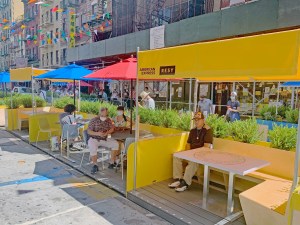New York Has 81,875 Metered Parking Spaces, And Millions of Free Ones
 Today’s New York Post story about City Council Member David Greenfield’s desperate push to squeeze a few more parking spaces out of New York City curb space reminded us of this neat little chart, which shows the total number of parking meters in the city, broken out into single-space meters and muni-meters. If Greenfield and other council members want to get serious about opening up curb space, they need to take a hard look at these numbers.
Today’s New York Post story about City Council Member David Greenfield’s desperate push to squeeze a few more parking spaces out of New York City curb space reminded us of this neat little chart, which shows the total number of parking meters in the city, broken out into single-space meters and muni-meters. If Greenfield and other council members want to get serious about opening up curb space, they need to take a hard look at these numbers.
The chart, put out by the city as part of its request for ideas on how to privatize its infrastructure, shows the total number of metered parking spaces increasing from 72,010 in 2006 to 81,875 in 2010. (That increase, most likely, isn’t due to adding meters to significant new stretches of the curb, but from single-space meters getting converted to muni-meters, which allow more cars to fit on a block.)
That’s an incredibly small number when taken in context. There are between 3.4 and 4.4 million on-street parking spaces in New York City, according to an extremely rough estimate by parking policy expert Rachel Weinberger, based on her field work in Park Slope and Jackson Heights.
Using those numbers, only 1.9 to 2.4 percent of all on-street spaces have a meter. Everywhere else, drivers can store their private vehicles on valuable public property at no cost, moving them only when alternate side parking rolls around. That’s an enormous giveaway of public space, and it also makes it harder for drivers to find parking. As long as there’s no price on so much scarce curb space, the search for an open spot is going to be pretty tough in a lot of neighborhoods.
Of course, it’s almost as scandalous that no official count of on-street parking exists. San Francisco became the first major city in the nation to tally all its parking last year, but New York has not followed suit. Right now, the city is turning to the private sector ostensibly to get as much as it can out of its parking infrastructure. Truly maximizing New York’s valuable curbside space, however, seems like it will be impossible as long as the city leaves some 98 percent of it completely unpriced and untracked.

